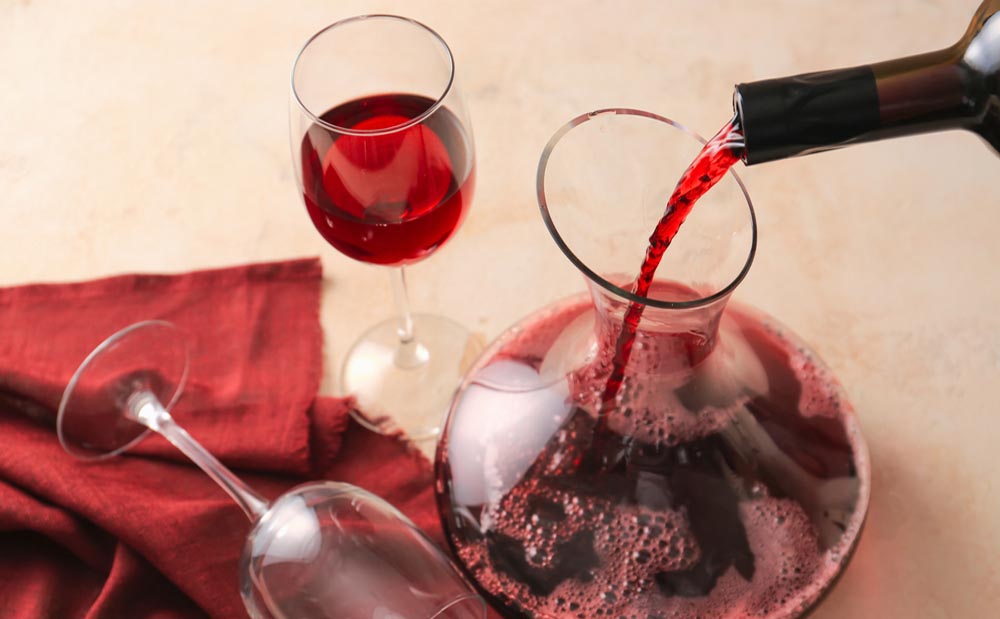
12 Aug Is It Better To Aerate Or Decant Wine?
Despite the similarities between aerating and decanting wine, several essential distinctions exist. Both aerate the wine—increasing its exposure to oxygen—as their primary goal. By increasing the wine’s surface area, you’re bringing more of it into direct contact with the surrounding air. This way, the wine can develop its full range of aromas and flavours more quickly.
There’s no guarantee that the process will be magical. Pinot Grigio is not transformed into a beautifully aged Montrachet by aeration. To put it another way, the aeration or limited oxidation process allows the wine’s potential complexity and subtlety to come to light sooner.
What Is The Distinction Between Aerating And Decanting?
Aerators are an excellent place to start. It’s common to practise using these as hand-held devices, but they can also be placed in or on bottles. Some variations include adding air to the instrument through which the wine flows, while others use multiple spouts to distribute the pour. When the wine is poured, they all increase the time that the wine is in contact with the air.
If your young, rich, and tannin-heavy red wine seems muted (closed) when you first open the bottle, use one of these discreet aerators to open it up and bring out more of the wine’s complexity. Aeration softens tannins, allowing the fruit and acid to sparkle through, which is one of its primary functions. Aeration is beneficial to almost all wines.
Quick Tip: For young wines, use an aerator, especially for bold, tannic reds. Older wines in delicate bottles can benefit from being served in a decanter.
On the other hand, most aerators do not remove the sediment found in some wines. For those who are unfamiliar, sediment is the grainy accumulation of solids in wine that frequently results from fermentation and unused yeast (lees). Sediment isn’t a problem for younger wines but is common in older bottles.
Some aerators can become clogged with sediment. If the flow of wine is disrupted, an unpleasant overflow situation may result. Older wines are typically better when they are aerated in a decanter. Most of the wine’s sediment can be retained in the bottle if it is poured slowly and correctly.
So, in order to stop pouring once sediment has reached the neck of the glass, a lot of sommeliers have used a candle or lights to light up the glass. Using this method, you can rest assured that the wine you’re drinking is only high-quality and won’t cause you to choke on sediment.
Wine decanting is a centuries-old tradition. The ritual of pouring an aged Burgundy into a gorgeous crystal decanter only enhances the experience.
To summarise, the general principle is straightforward. An aerator is the best way to aerate young, bold, and tannic wines. Decanting is necessary when dealing with older wines that are more delicate and fragile, so grab a decanter and exercise caution.
The best way to aerate young wines is to use two decanters and aerate the wine twice.
You can do a few simple things to ensure that your reds and whites are getting the most out of their potential. Both methods have advantages and disadvantages, depending on the type of wine you’re preparing.
Custom Wine Cellar Design and Installation
Whatever your taste in wine, you’ll need a place to keep it. Choose a well-known and well-respected wine cellar installation company to help you with your project. Your home’s aesthetic and layout will be considered when determining which design concepts or themes best suit your home’s style and structure.
Because of this, the custom wine cellar features and elements we create for you will be durable, long-lasting, and aesthetically pleasing. We achieve this by utilising the highest quality products, materials, and installation methods.
For information about our custom wine cellar design and installation solutions, call Signature Cellars on 1300 570 636. Our team is here to help with your wine cellar planning needs from start to end so that you have the sophisticated and functional wine cellar of your dreams.
Thanks for reading,
Signature Cellars
1300 570 636




No Comments